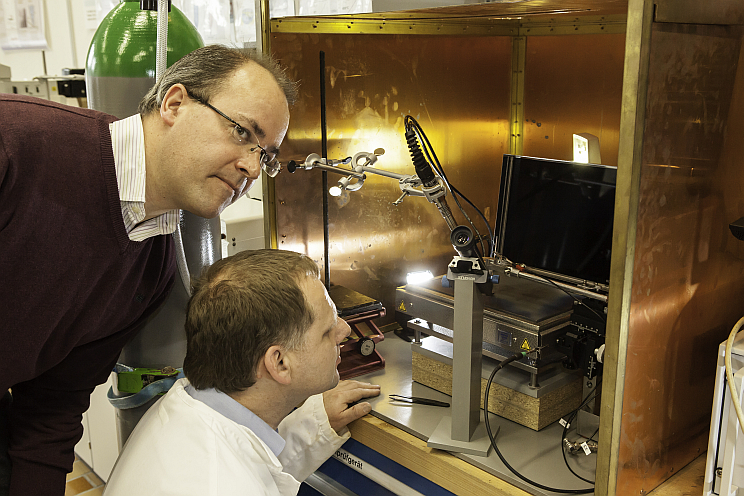| Lars Jeurgens and his colleague Thomas Suter (right side) check a new test set-up.
As a teenager, Lars Jeurgens was fascinated with minerals and fossils. He looked after and cared for his collection with enthusiasm. It was this passion that influenced him to make the decision to study geology in Utrecht. He quickly noticed that geologists (at the time) were also concerned with matters concerning materials science. For example, one goal was to discover how heavy metals got into the atmosphere and what effect they had there. This topic caught Jeurgens’s interest. He focused his attention on how chromium and tungsten could be filtered out of the environment, rivers, for instance, and experimented with porous oxides for binding the dissolved metals in water, therefore making an initial excursion into the chemistry of boundary layers.
From drill holes to turbine blades
After completing his master’s degree, the 23-years-old changed track and applied his knowledge in physics and chemistry to his job working for mineral oil company Shell. During his work in the laboratory, he had used nuclear magnetic resonance spectroscopy (NMR) to investigate pore fluids in oil-bearing rocks. The method can also be used to analyze the oil content of undersea rock layers. This kind of research was "extremely interesting" in Jeurgens's words, though, without a doctorate, he could not continue to pursue it as project leader.
After working for Shell for a year he therefore enrolled at Delft Technical University. During his doctorate he studied the initial stages of metal oxidation and, as a postdoc, he looked into heat-resistant coatings for the blades of airplane turbines. Jeurgens was involved in the development of a surface treatment that would extend the service life of such a protective coating. Among other things, the scientists collaborated with a Dutch company that was taken over by the Swiss Sulzer Group shortly afterwards. "The partners from the aircraft industry patented our procedure, although it remains a closely-guarded secret as to whether it is actually being used in the field", explains Jeurgens with his soft Dutch accent, which the Swiss find so agreeable.
|


